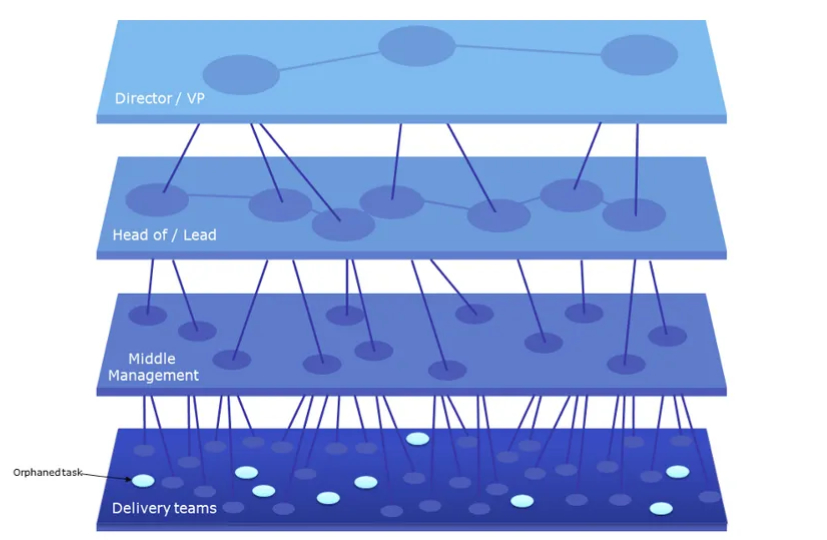In physics, dissipation is the result of the irreversible process, by which energy transforms from an original form into another final form.
In the organizational context, by the term dissipation of vision, we describe the fading (or loss) of the messages from the more senior members of an organization when it traverses through the corporate engine’s cogs until it reaches the person lowest in the hierarchy.
Every organization will exhibit the dissipation of vision as long as it has some kind of hierarchical structure. We expect the intensity of the dissipation of visionto be analogous to the number of hierarchy levels in an organization.
This is how it works
- The top management (typically C-level or a level below such as VP) comes up with the company mission or a product vision e.g. product presence in five countries. This is high level, it’s an anticipation, similar to a wish, but with corporate value behind it.
- This message then gets picked up by the level below in the organization (e.g. Director) and becomes a division strategy with more specific goals e.g. timelines, budget and target groups. Risk: Introduction of goal ambiguity
- Continuing one level down, to the Lead of Head of levels, and these strategic goals become even more fine-grained goals to the various departments e.g. the technology department picks up the development of the product, the business department the customer journeys and customer specifications, the marketing department the various marketing channels and so on. Risk: Scope narrowing steering away from a common strategy
- Further down, the message has been split amongst the various team managers who are responsible for a piece of the strategic goal that has a very narrow focus. Sometimes it’s so narrow that it cannot exist as a stand-alone target, and it needs many lateral teams to work together, with any complications and delays that this might cause. Because these are managed by individuals, we observe prioritization taking a hit at this stage. Risk: Loss of prioritization ability
- Finally, at the team level, individual members of the teams are responsible for their daily / weekly tasks for a fraction of the team’s overall delivery. Here we see orphaned tasks emerge, meaning that they don’t bind back with the original company vision and strategy, therefore adding waste to the delivery process. Risk: Addition of waste

The above scenario looks like a natural task decomposition for execution and delivery. However, if we observe closely, and this is the problem with the dissipation of vision, usually by the time the tasks have reached the delivery area (5), there is no clear connection with the original vision that originated from the senior management (1). The tasks have become deliverables of the teams’ agenda and, as far as the delivery teams are concerned, that’s the end of it. There is no vision and no greater goal as these have remained at the Lead or Head of level. Further, a number of risk factors have been introduced that snowball to the lowest levels. Ultimately, this leads to a company functioning tactically and not strategically, and employees crunching away everyday tasks, estranging themselves from the bigger picture, the “why we do things”.

How to minimize the dissipation of vision
I don’t expect the dissipation of vision to ever reach zero values within an organization. However, the flatter the organizational structure (less hierarchy) and the stronger the communication are, the less dissipation of vision we will observe. A few things that can also contribute are:
- Raise various information radiators at multiple points that remind the vision and strategy to everyone in the organization
- Bind anything and everything that you do under a common vision and strategy. Ensure that everyday tasks serve a larger purpose, and that purpose is explicitly entrenched in the task.
- Communicate the vision and strategy often, and make them the epicenter of discussions, QBR and all-hands
- Request feedback from all the levels of the organization, with regard to the understanding of the company’s vision and strategy. Adjust your actions, depending on that feedback.

